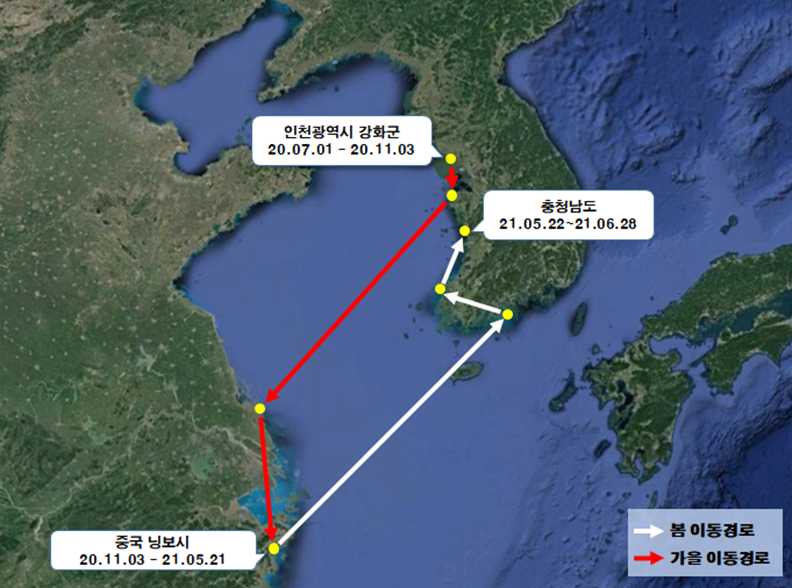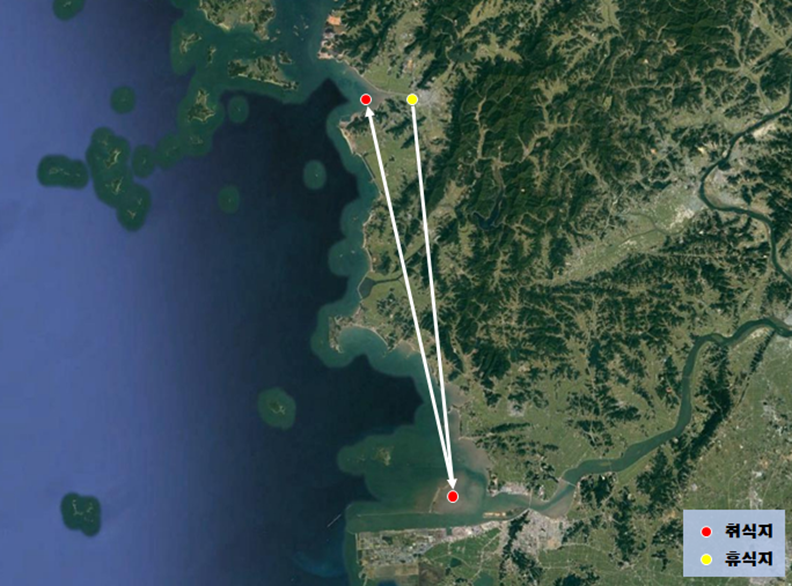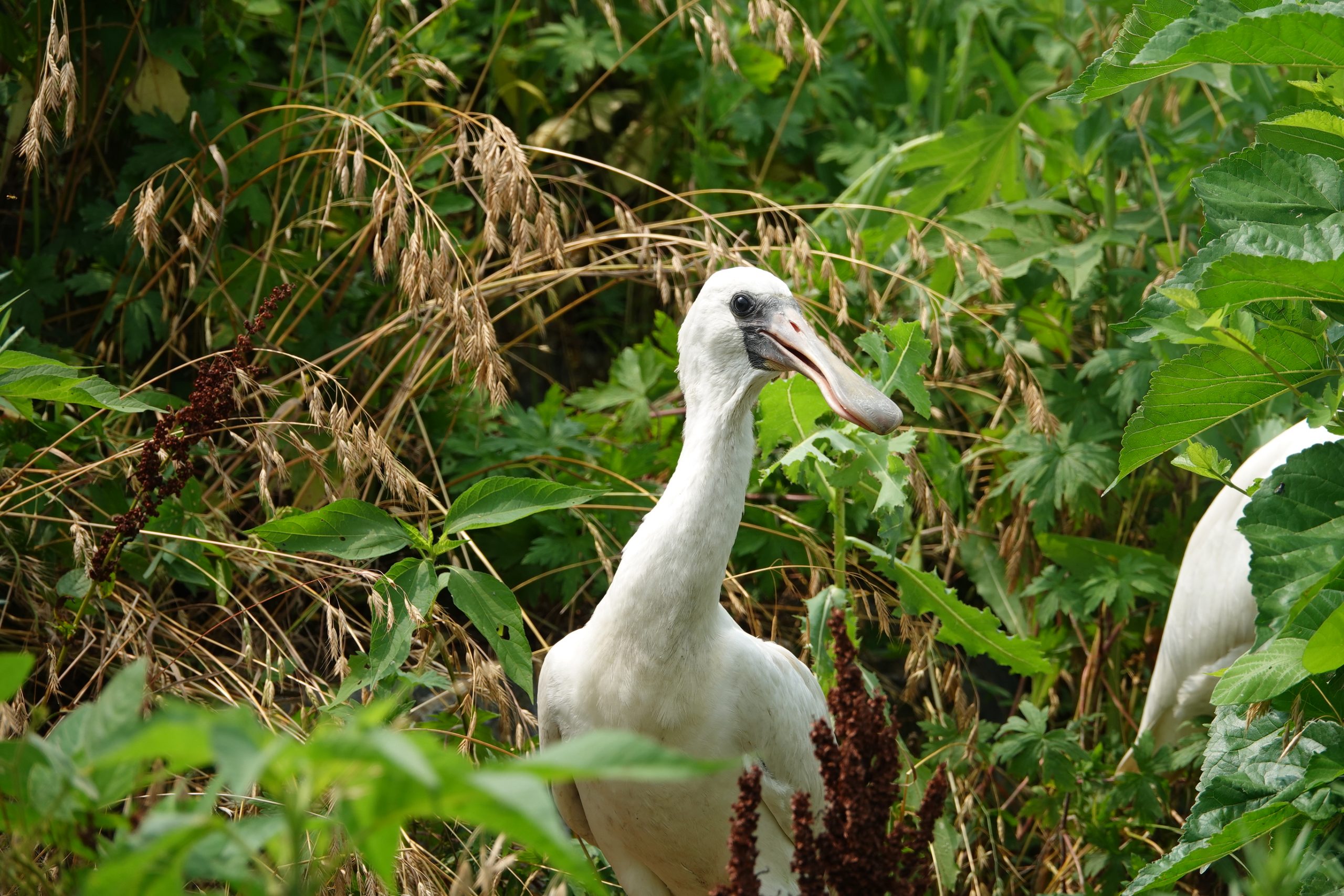Written by Dr. Inki Kwon (National Institute of Ecology)
Since its artificial breeding in July last year, a Black-faced Spoonbill returned from China to Korea in May 2020, after wintering in Ningbo, China.
The National Institute of Ecology (NIE), of the Ministry of Environment in the RO Korea has recently confirmed that the Black-faced spoonbill (EN of the IUCN Red List & Korean National Endangered species class I), which had been released and flown abroad after its artificial breeding in July 2019, returned to Korea in a year for the first time.
The Black–faced Spoonbill (Y21) which is the one of the five (Y21-25) individuals released from tidal flats of Ganghwa County on July 1 in 2019. Researchers of the NIE conducted a one-year wild adaptation to the 5 Black-faced Spoonbills. 4 were artificially bred after being rescued in Ganghwa County on May 15 when they had been eggs, while one juvenile bird, was rescued in Songdo Mudflat on August 26 in 2019.
The Black-faced Spoonbill (Y21), which had wintered in Liyang Bay, China, moved to Taigang Bay in the north on April 24 in 2020 and stayed for 28 days before flying through 800 kilometers on May 21. Then it arrived in Goheung County, Jeollanam Province on May 22.
Another (Y24) has been confirmed to live in Taifu, Suzhou until March this year by a birdwatcher after moving to China, and the other (Y25) has not been identified.
Dr. Park Yong-mok, head of the National Ecological Institute, said, “The return of the artificially bred Black-faced Spoonbill to Korea is a meaningful study for conservation of endangered species in East Asia. We will continue to work with major wintering countries such as China, Taiwan and Japan.”

The route of the Black-faced Spoonbill (Y21)

Source:
Website of the National Institute of Ecology: https://www.nie.re.kr/contents/siteMain.do?mu_lang=ENG
Korean Version
인공증식으로 방사한 멸종위기종 저어새 1년 만에 복귀
- 국내외 처음 인공증식 후 지난해 7월 방사한 저어새 중국에서 돌아와
- 중국 닝보시에서 겨울 보내고 올해 5월 우리나라에 복귀
환경부 산하 국립생태원(원장 박용목)은 지난해 7월에 국내외 처음으로 인공증식 후 방사한 멸종위기 야생생물 Ⅰ급 저어새가 1년 만에 우리나라로 돌아오는 것을 최근 확인했다고 밝혔다.
주걱모양의 부리가 특징인 저어새는 세계자연보전연맹(IUCN)의 적색목록에 멸종위기(EN)로 분류된 여름철새로 우리나라를 비롯해 중국, 대만, 필리핀 등 동아시아 지역에만 서식한다. 특히 전 세계 약 90%의 번식쌍(2020년 기준 1,548쌍)이 우리나라 서해안 일대에서 번식한다.
이번에 돌아온 저어새는 국립생태원 연구진이 2019년 5월 15일 인천 강화군에서 만조 시 물 속에 잠길 우려가 있는 10개의 알을 구조하여 인공 증식한 4마리와 같은 해 8월 26일 인천 송도 갯벌에서 구조한 어린새끼 1마리를 대상으로 1년간의 야생적응훈련을 실시한 후 지난해 7월 1일 강화도 갯벌에서 방사한 5마리(Y21~25) 중 1마리(Y21)이다.
연구진은 3마리(Y21~23)를 위치 추적기와 가락지를 달아 방사했고, 나머지 2마리(Y24~25)는 가락지만 달아 방사했다.
이번에 돌아온 저어새(Y21)는 지난해 11월 3일 우리나라를 출발해 11월 4일 중국 저장성 닝보시 리양 만에 도착했다.
중국 리양 만에서 월동하던 이 저어새는 올해 4월 24일 북쪽에 위치한 타이갱 만으로 이동하여 28일간 체류하다가 5월 21일 800km를 비행한 끝에 5월 22일 전남 고흥군에 도착했다.
현재 이 저어새는 전남 영광군 갯벌과 칠산도를 거쳐 현재 충남 보령 해안 일대에서 활동 중이다. 국립생태원 연구진이 최근 보령 해안 일대의 현장을 조사한 결과 이 저어새는 단독으로 생활하지 않고 다른 저어새 4마리와 멸종위기 야생생물 Ⅱ급인 노랑부리저어새 1마리와 무리를 이루고 있다.
한편 방사한 나머지 저어새 4마리 중 2마리(Y22, Y23)는 중국 등 월동지로 이주하지 않다가 지난 겨울 죽은 것으로 확인됐다. 다른 한 마리(Y24)는 중국에 이동한 후 현지 탐조가에 의해 올해 3월까지 쑤저우시 타이후에서 서식하는 것이 확인됐으며 또 다른 한 마리(Y25)는 관찰 정보가 확인되지 않았다.
박용목 국립생태원장은 “이번 인공증식 저어새의 우리나라 복귀는 동아시아 고유의 멸종위기종인 저어새의 보전을 위해 의미가 있는 연구 결과”라며, “번식지와 월동지를 함께 보호하는 국제협력 연구가 필수적인 만큼 중국, 대만, 일본 등 주요 월동국가와 함께 국제협력 연구를 지속해 나가겠다”라고 말했다.
출처 : 국립생태원 홈페이지: https://www.nie.re.kr





